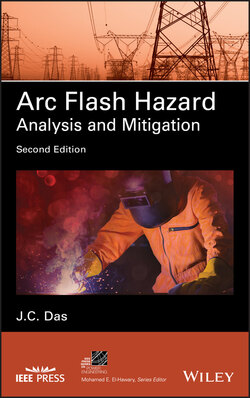Читать книгу Arc Flash Hazard Analysis and Mitigation - J. C. Das - Страница 10
FOREWORD
ОглавлениеAs is common with emerging technologies, the maturity of safety considerations for a technology may lag the momentum in applying the technology. This has been true with the industrial, commercial, and residential electrification of modern society that began in the late nineteenth century. While human contact with electricity was known to be hazardous, differentiating arc flash from electric shock did not receive significant attention until a century later. We now know that injuries from arc flash events in electric power systems are among the most traumatic and costly occupational injuries. The intense energy transfer occurring in a fraction of a second converts electrical energy into thermal, blast, acoustic, chemical, and electromagnetic components that individually have their own injury consequences. Collectively, these energy transfers to the human body produce complex physical, neurological, and emotional trauma that are very difficult and costly to treat and rehabilitate. The resulting tragedy not only impacts the injured person, it extends to family, friends, and coworkers. And that is just the human side. Arc flash events also damage vital infrastructure, disrupting operations and damaging critical equipment. Altogether, the consequences in human suffering, equipment damage, and disruption of essential electrical systems can be extraordinary. But they can be prevented.
Increasing awareness of arc flash hazards has inspired improvements in administrative control measures, including safe work practices and application of personal protective equipment. These are important components of a comprehensive solution in reducing the risk of injury, but they have limitations. Administrative control measures are susceptible to human error that occur in real time with little opportunity for recovery from gaps in knowledge, misinterpretation of conditions, or lapse in discipline. Personal protective equipment for arc flash events is currently limited to thermal and acoustic hazards and may only reduce severity of injury as opposed to completely protecting the individual from injury. Injuries from the blast forces and respiratory harm from toxic chemicals and hot gases have been difficult to address with personal protective equipment. There is a more comprehensive answer, one that includes engineering solutions that reduce the potential for an arc flash event, minimize total energy transfer, and reduce the frequency of exposure.
Increasing awareness of arc flash events and consequences has generated research and publication across engineering, science, health and safety, medical, and legal disciplines. J.C. Das has researched this body of knowledge and brought together innovative ideas and practical concepts with abundant references and real world case studies in arc flash analysis and mitigation. For the first time, design engineers, facility managers, safety professionals, and operating and maintenance personnel have a comprehensive reference for prevention methods. Arc Flash Hazard Analysis and Mitigation provides a comprehensive set of tools to aid in the design, evaluation, and redesign of electric power systems. There is no single “silver bullet” for arc flash mitigation, yet following the methodology and analyses discussed in the book, professional engineers and power system designers can design new industrial electrical systems and modify existing systems to limit arc flash hazard incident energy to no more than 8cal/cm2. Chapter 15 of the book presents innovative ideas for arc flash analyses in DC systems. The analysis tools enable comparison of mitigating technologies and choices in system design to optimize arc flash risk for the life of the facility. For the workers at risk, the engineering solutions serve to automatically reduce risk and function independently of their knowledge, skills, and vulnerability to human error.
We are on a journey in arc flash mitigation. Ongoing basic research will continue to explore the complexities of the arc flash phenomena. Equipment manufacturers will introduce more innovative products to eliminate or reduce exposure. Protection engineers will refine methods to sense and interrupt faults faster. Reliability engineers will help address the problem of hidden failures in circuit protection hardware, software, and schemes. Facility engineers will become more knowledgeable in demanding prevention through design. Workers will be better protected from arc flash hazards. Arc Flash Hazard Analysis and Mitigation provides a roadmap. For the next worker at risk of a permanently disabling, life-changing arc flash injury, we need to accelerate our journey.
H. Landis “Lanny” Floyd
June 2012
H. Landis “Lanny” Floyd is Principal Consultant, Electrical Safety and Technology with DuPont. He is a fellow of IEEE and recipient of many awards, including the 2002 IEEE Richard Harold Kaufman award for advancing the development and application of electrical safety technology and the 2004 IEEE Medal for Engineering Excellence for contributions in arc flash analysis and mitigation. He has written more than 70 papers and articles on workplace electrical safety. He is also the Editor of the IEEE Industry Applications Magazine. He is a nationally and internationally recognized safety expert.
